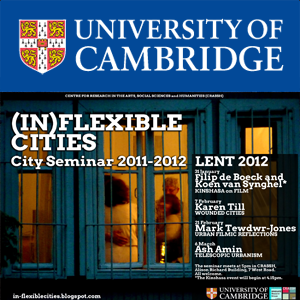City Seminar - 26 November 2013 - Gated/Gating Community: The Settlements Complex in the West Bank
Duration: 47 mins 47 secs
Share this media item:
Embed this media item:
Embed this media item:
About this item

| Description: |
Ariel Handel (Tel Aviv University)
Abstract The claim that the settlements in the West Bank are gated communities might seem trivial. Those are an explicit example of a community featuring, on the one hand, social cohesion based on shared values, while, on the other hand, self-isolation with the help of fences and a stress on the “security of the community.” The argument of this paper, however, is different. The paper suggests that the settlement layout in the West Bank is not just an aggregate of 124 “legal” gated communities and a similar number of “illegal outposts,” but rather a single, contiguous gated community gating, in turn, Palestinian “islands” within it. The reading I will offer seeks to look at the space in question through a careful reading of its use values. The emphasis is put on the question of mobilities in order to show how the fortressed points turn into an exclusionary web by means of separated roads and movement restrictions. By analyzing the combined system of settlements, roads, military legislation, spatial design and applied violence, the paper shows how the few hundred points consolidate into one coherent spatial system. The paper wishes to contribute both to the spatial analysis of Israel's now 45 years-old occupation of the West Bank, to the growing study of politics of mobility, and to the discourse of gated communities by adding colonialism and violence to the mostly neo-liberal explanations of the phenomenon. |
|---|
| Created: | 2013-12-09 10:22 |
|---|---|
| Collection: | City Seminar |
| Publisher: | University of Cambridge |
| Copyright: | Glenn Jobson |
| Language: | eng (English) |
| Distribution: |
World
|
| Keywords: | CRASSH; City Seminar; |
| Explicit content: | No |
| Abstract: | Ariel Handel (Tel Aviv University)
Abstract The claim that the settlements in the West Bank are gated communities might seem trivial. Those are an explicit example of a community featuring, on the one hand, social cohesion based on shared values, while, on the other hand, self-isolation with the help of fences and a stress on the “security of the community.” The argument of this paper, however, is different. The paper suggests that the settlement layout in the West Bank is not just an aggregate of 124 “legal” gated communities and a similar number of “illegal outposts,” but rather a single, contiguous gated community gating, in turn, Palestinian “islands” within it. The reading I will offer seeks to look at the space in question through a careful reading of its use values. The emphasis is put on the question of mobilities in order to show how the fortressed points turn into an exclusionary web by means of separated roads and movement restrictions. By analyzing the combined system of settlements, roads, military legislation, spatial design and applied violence, the paper shows how the few hundred points consolidate into one coherent spatial system. The paper wishes to contribute both to the spatial analysis of Israel's now 45 years-old occupation of the West Bank, to the growing study of politics of mobility, and to the discourse of gated communities by adding colonialism and violence to the mostly neo-liberal explanations of the phenomenon. |
|---|---|

